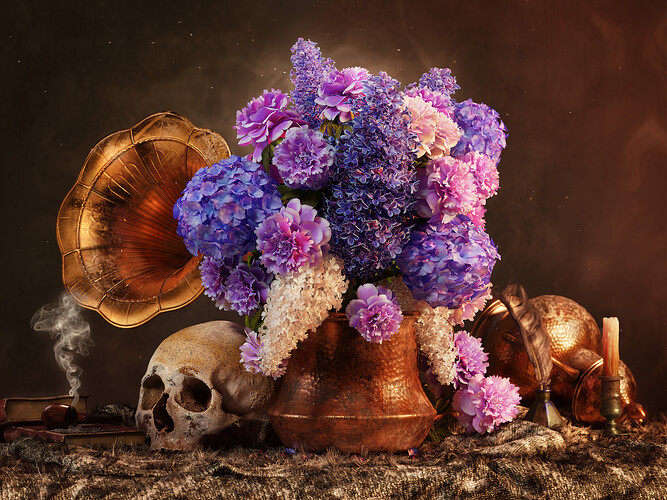Hello Blender artists! I have put my other personal project Mustang Car Animation on hold for now as I am well into a new Blender-based full-time job, which I am enjoying very much. I also have a huge rendering issue that is affecting all my darker projects, see the bottom of this post if you think you can help please.
I had a little spare time between projects so I wanted to redo a piece I did in 2022 as a means of benchmarking my technical and creative progress.
Above is the finished piece from 2024, below is the 2022 version:
Old Version Below
Unlike the majority of my personal projects, this does utilise more stock assets than I would normally like. However, I think for a medium-sized scene like this with lots of details it is less about modelling and more about lighting, composition and texturing. Think of it as ‘how would a photographer or painter setup this scene?’. I had to redo a lot of the textures and materials that came with the stock assets, some more so than others.
The Objectives
The goals when approaching this 2024 redux versus the 2022 version:
- More focus on making the colours match the baroque 17th century Flemish painting style. Which includes higher contrast and deeper darker black areas. Slight over-saturation of the bold colours to contrast against some pastel colours of the flowers.
This was my first time using the Agx ‘Punchy’ view transform. I like the Agx view transform, but the Punchy contrast type tends lose a lot of the detail in the bright and especially dark areas, but that is perfect for this style of image.
-
More natural lighting appearance, The old version is clearly a studio setup. Nothing wrong with that but its not what I wanted.
-
Wider view, to give the space more life and purpose.
-
Stop relying on dust motes and god rays: I tend to overdo the god rays and dust motes in all my moody-lit work. While it would be acceptable here, I want to get away from relying on extra layers of post-processing type ‘screen-clutter’.
-
Textures and materials: Make the textures and materials more believable, particularly when looking at the flowers and fruit. I maybe didn’t achieve this as well as I’d have hoped, but you get away with more considering the wider camera lens. Too far away to tell. Maybe in 2026 when I redo this again I would like to make the flowers myself, scanning and photographing everything manually.
Viewport for the intrigued:
The Problem
I really really want to animate this, possibly making the flowers wilt and the fruit perish. However, I have the same issue with this project as I do with my Mustang project: I cannot maintain the tiny details (dust mostly), as the denoiser smudges and blurs them. This image took nearly 13minutes, at 1750 samples, 2000x2000px on an RTX 3070ti. I actually used the non-denoised image output as the fireflies aren’t important for a single still. But for an animation, I will need to come up with a different solution that isn’t just ‘buy a 4090’. I have tried clamping the direct/indirect light values but this doesn’t stop the issue as much as I’d have hoped.
This is a huge issue for me, any advice would be greatly appreciated.


